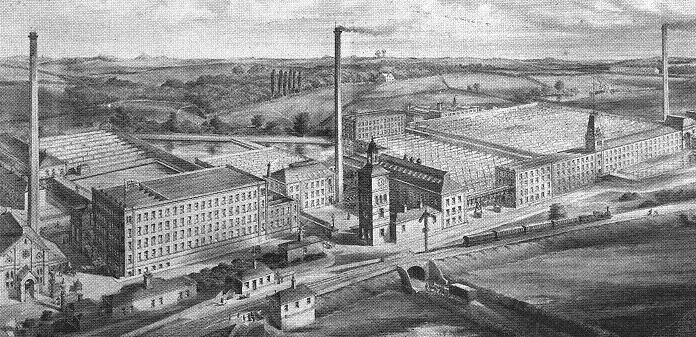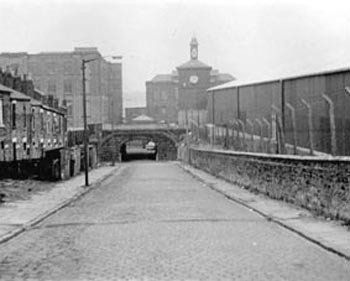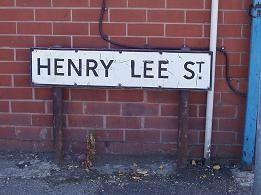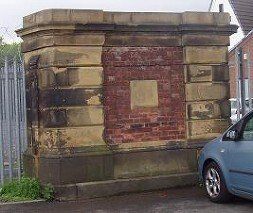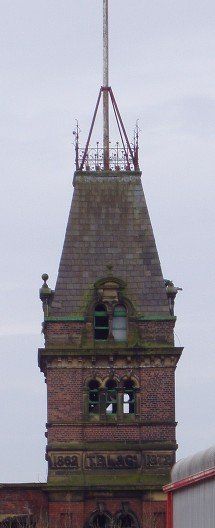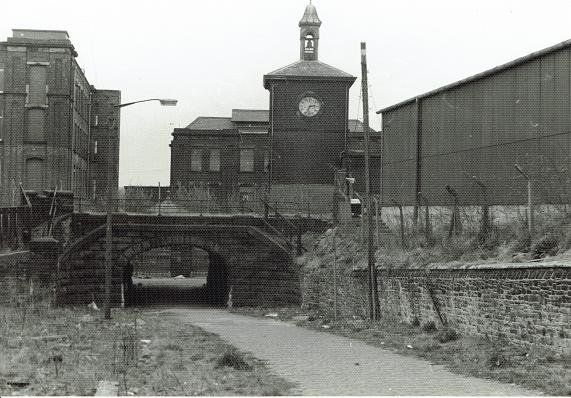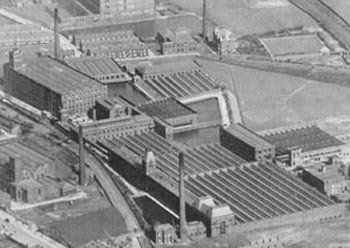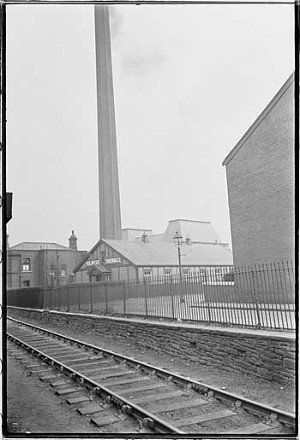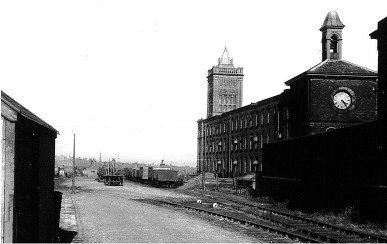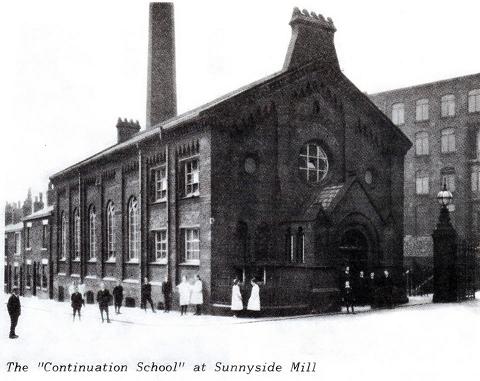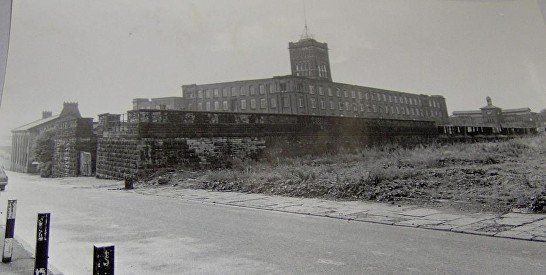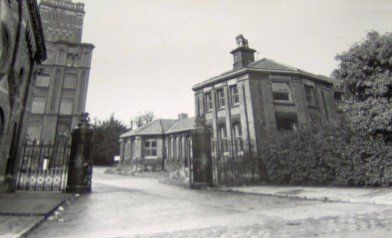This Bolton Archives picture of Sunnyside Mills is not a totally true representation of what it looked like and was probably drawn BEFORE the mills were built to show people what was intended. Compare the building to the right of the clock tower on the aerial view and the picture lower down the page with the drawing. Compare also the Barrier Street bridge.
This indicates that the supposition that the buildings near the bottom left, either side of the railway, were the original Daubhill Station (as quoted by Leslie Gent in "Bolton Past") has no substance. These buildings may never have existed.
There is a short street off St Helens Road (now leading to Majestic Van Hire) named Henry Lee Street to commemorate the man who brought the cotton industry to Daubhill. At the end of the street gateposts for one of Sunnyside Mills entrances still stand.
“In 1853 Henry Lee was a partner in the local firm of Tootal, Broadhurst and Lee, a small manufacturer of muslins based close the town centre in Stanley Street, which ran until recently from the bottom end of Deane Road down towards the railway line. The new sixth-form college was recently built on the site.” (source?)
(This is dubious. Grace’s Guide article on Sunnyside Mills states that the precursor to TBL was founded in Manchester, by Robert Gardner, a textile merchant, in 1799 and that Tootal family involvement began in 1842. Henry Lee also had a factory in Atherton still under his own name in 1891. It also states that in the 1860s Sunnyside Mills along with Newton Heath Mills in Manchester were “acquired”. TBL was hardly small and “based in Stanley Street”!)
In 1860 Lee bought a small weaving mill and engine house in Daubhill. (source?) (Was this Lee personally or TBL? Perhaps we assume that Henry Lee owned the Stanley Street mill, the Atherton mill and maybe others and he personally “acquired” a small weaving mill at Daubhill and was a big enough player to join with Tootal’s and the Gardner company on equal terms. It is clear that it was TBL and not Lee alone who built the Sunnyside Mill complex.)
Between 1862 and 1867 with further extensions in 1872 Tootal, Broadhurst and Lee built the imposing Sunnyside Mills on land bounded by the Bolton and Leigh railway line, Adelaide Street and Crowshaw Lane (named along with Crowshaw Brook and later re-named Ellesmere Road). The central tower, which still remains, has a superscription 1862 T.B.L & Co 1872. (February 2016 - the present owners have applied to Bolton Council for permission to demolish the tower and the remaining mill building. Later 2016 - the tower has been demolished. Why oh why was it not listed?)
The mill was the main source of employment for the people of Daubhill from this time through to the 1950s. The mill closed in 1980 and most of it was demolished. Sadly the clock tower disappeared at this time instead of being retained as the local landmark and feature that it truly was. The separate Rumworth Mill was used by Lantor who have now (2015) moved to a small building nearby while the factory has been renamed "Stirling". The tower and the half of the mill building to the east of this were still standing in an almost derelict state (2012) but have since been demolished. Most of the terraced housing in the area would have been built for the work force of Sunnyside Mills and the later Swan Lane Spinning Mill (1902).
Barrier Street (Shed Lane) - F Boardman -
showing the clock tower.
Barrier Street railway bridge and the clock tower, (C) Fred Hosker / Jackie Nisbet with permission.
Aerial view of Sunnyside Mills, St Helens Road across the bottom left corner. Rumworth Mill is between this and the 1828 railway line. Then we have the Sunnyside Mills complex. Across the top right corner is the 1885 railway. In from there is the Sunnyside Hotel and to its left the long slope of Ellesmere Road leading up to the railway bridge.
The immense west-most chimney of the site behind the Holiness Tabernacle with the 1828 railway at the front of the picture, the level crossing being just off shot to the right. (C)Bolton archives - worktown collection 1937 (?)
Sunnyside Mills 1952 (C)Harold D Bowtell
Click on a picture and navigate.
For some time around 1900 Sunny Mills had its own “continuation school”. It was on the mill site with its frontage on Adelaide Street immediately down from the railway sidings. Children left school at twelve and went intert’ mill. The school syllabus is not known, but must have continued the reading, writing and arithmetic the children had not gained sufficient proficiency in at Junior School. One would assume however that its timetable included all that these young workers would need to know about workin’ i’ t’ mill.
Olive Readey's parents' picture, with permission
View of the eastern building of Sunnyside Mills looking down Adelaide Street. The original railway crossed Adelaide Street at this point which was the top end of the rope hauled incline. When the railway was rerouted in 1885 the original track was preserved as far as this point as a branch line to deliver coal and probably raw cotton to the mill. What appears to be one side of a bridge is an elevation of the track preserving the level of 200 yards west and creating coal hoppers for the easy unloading of coal wagons. However the line did cross Adelaide Street on a bridge named Bolton Bridge, which seems odd in that it increased the height of the "incline" though it removed the need for a level crossing. Notice the "continuation school" at the left of the picture. The gate house was just below this.
Olive Readey's parents' picture, with permission)
Gate house for Sunnyside Mills on Adelaide Street.
Next Page - 1878 St Helens Road / 1885 Railway

